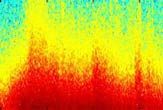Eerie Underwater Recording of Deadly Indonesian Earthquake

Sound from last December's huge tsunami-causing earthquake was picked up by underwater microphones designed to listen for nuclear explosions.
Scientists this week released an audio file of the frighteningly long-lasting cracks and splits along the Sumatra-Andaman Fault in the Indian Ocean.
The spine-tingling hiss and rumble is an eerie reminder of the devastation and death that is still being tallied in the largest natural disaster in modern times.
At least 200,000 people are thought to have died as a result of the magnitude 9.3 earthquake, the tsunami, and the lack of food, drinkable water and medical supplies that followed.
The audio recording of the quake starts out silent. A low hiss begins and the intensity builds gradually to a rumbling crescendo. Then it tails off but, frighteningly, builds again in waves as Earth continues to tremble.
The audio file [here] is sped up 10 times to make it easier to hear. As it was recorded, the sound was at the lower threshold of human hearing, but it could have been noted by someone paying attention.
"If you were diving even hundreds of miles away you could hear this," said study leader Maya Tolstoy of Columbia University's Lamont-Doherty Earth Observatory. "You would hear it as sort of a 'boom.'"
Sign up for the Live Science daily newsletter now
Get the world’s most fascinating discoveries delivered straight to your inbox.
Future help
An analysis of the recording suggest a new way to monitor earthquakes in near real-time, providing critical information about an earthquake's intensity and potential hazard that could supplement seismograph data, which typically requires hours and even days to properly analyze.
"We were able to constrain some details such as the speed and duration of the rupture more accurately than traditional seismic methods," Tolstoy said. "Moreover, we found the earthquake happened in two distinct phases, with faster rupture to the south and slower to the north, almost as if there were two back-to-back events."
Tolstoy told LiveScience that the recorded sounds raced from the rupture more quickly than the tsunami wave. The entire quake's sounds took about 45 minutes to reach the hydrophone. Were a system set up to use such data, analysis might be done in about 15 minutes, Tolstoy said.
The tsunami took hours to reach some locations.
An analysis of the data is detailed in the July/August edition of the journal Seismological Research Letters.
Sound travels
It is not surprising the sounds were picked up.
An earthquake releases energy of varying types. Its seismic waves -- those that shake the ground -- are technically just a variation on sound waves. And sound travels well in water. Whales can hear each other call from more than 1,000 miles away.
Tolstoy said people at sea have heard the rumblings of distant volcanoes when the sound hits the hull of a ship.
And this was no small earthquake. It ruptured the planet along 750 miles (1,200 kilometers) of fault. Scientists estimate the Indian plate slipped 33-50 feet (10 to 15 meters) under the Burma microplate. The fault shook for at least eight minutes. A typical large earthquake lasts 30 seconds or so.
Earth's very gravity balance was altered and the North Pole shifted by an inch.
The recorded data was provided in March to scientists by the International Monitoring System of the Comprehensive Nuclear Test Ban Treaty. Tolstoy and her colleague, DelWayne Bohnenstiehl, converted the data to make the new audio file.
Tolstoy hopes that in the future scientists will gain easier and earlier access to such data.
"There is an opportunity here to make a contribution to international disaster monitoring, as well as help us better understand earthquakes and tsunamis and potentially mitigate these events in the future." she said. "It makes sense to let others listen in."
- Top 10 Ways to Destroy Earth
- The Mystery of Desert Music
- Tsunami Special Report
- Earthquake Myths
A spectrogram of the data shows energy released, with red being the most. A peak in energy is seen about 300 seconds into the event. Credit: Lamont-Doherty Earth Observatory
Robert is an independent health and science journalist and writer based in Phoenix, Arizona. He is a former editor-in-chief of Live Science with over 20 years of experience as a reporter and editor. He has worked on websites such as Space.com and Tom's Guide, and is a contributor on Medium, covering how we age and how to optimize the mind and body through time. He has a journalism degree from Humboldt State University in California.











